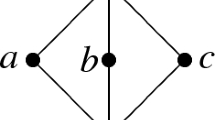Abstract
In this work, we propose a new quantum structure—weak quantum MV algebras (wQMV algebras)—and define coupled bimonoids and strong coupled bimonoids. We find that the coupled bimonoids and strong coupled bimonoids are ring-like structures corresponding to lattice-ordered wQMV algebras and lattice-ordered QMV algebras, respectively. Using an automated reasoning tool, we give the smallest 4-element wQMV algebra but not a QMV algebra. We also show that lattice-ordered wQMV algebras are the real nondistributive generalization of MV algebras. Certainly, most important properties of quantum MV algebras (QMV algebras) are preserved by wQMV algebras. Furthermore, we can conclude that lattice-ordered wQMV algebras are the simplest unsharp quantum logical structures by far, based on which computation theory could be set up.




Similar content being viewed by others
References
Birkhoff G, von Neumann J (1936) The logic of quantum mechanics. Ann Math 37(4):823–843
Chang CC (1958) Algebraic analysis of many valued logics. Trans Am Math Soc 88:467–490
Chang CC (1959) A new proof of the completeness of the Łukasiewicz axioms. Trans Am Math Soc 93:74–80
Chiara MD, Giuntini R, Greechie R (2004) Reasoning in quantum theory—sharp and unsharp quantum logic. Kluwer Academic Publishers, Dordrecht
Di Nola A, Gerla B (2005) Algebras of łukasiewicz logic and their semiring reducts. In: Litvinov GL, Maslov VP (eds) Idempotent mathematics and mathematical physics. Contemp. Math., vol 377, pp 131–144. American Mathematical Society, Providence
Dvurečenskig A, Pulmannová S (2000) New trends in quantum structures. Kluwer/Ister Science, Dordrecht/Bratislava
Foulis DJ, Bennett MK (1994) Effect algebras and unsharp quantum logics. Found Phys 24(10):1331–1352
Gerla B (2003) Many-valued logic and semirings. Neural Netw World 5:467–480
Giuntini R (1996) Quantum MV algebras. Studia Logica 56:393–417
Giuntini R (1998) Quantum MV-algebras and commutativity. Int J Theor Phys 37(1):65–74
Giuntini R (2005) Weakly linear quantum MV-algebras. Algebra Univers 53:45–72
Giuntini R, Greuling H (1989) Toward a formal language for unsharp properties. Found Phys 20:931–935
Gudder S (1995) Total extensions of effect algebras. Found Phys Lett 8:243–252
Kalmbach G (1983) Orthomodular lattices. Academic Press, New York
Kôpka F, Chovanec F (1994) D-posets. Math Slovaca 44:21–34
Ludwig G (1983) Foundations of quantum mechanics, vol 1. Springer, Berlin
Qiu DW (2004) Automata theory based on quantum logic: some characterizations. Inf Comput 190(2):179–195
Qiu DW (2007) Automata theory based on quantum logic: reversibilities and pushdown automata. Theor Comput Sci 386:38–56
Shang Y, Lu RQ (2007) Semirings and pseudo MV algebras. Soft Comput 11:847–853
Shang Y, Lu X, Lu RQ (2009) Automata theory based on unsharp quantum logic. Math Struct Comput Sci 19:737–756
Shang Y, Lu X, Lu RQ (2012) A theory of computation based on unsharp quantum logic: finite state automata and pushdown automata. Theor Comput Sci 434:53–86
Ying MS (2000a) Automata theory based on quantum logic (I). Int J Theor Phys 39(4):981–991
Ying MS (2000b) Automata theory based on quantum logic (II). Int J Theor Phys 39(11):2545–2557
Ying MS (2005) A theory of computation based on quantum logic (I). Theor Comput Sci 344(2,3):134–207
Zhang J, Zhang H (1995) SEM: a system for enumerating models. In: Proceedings of international joint conference on AI (IJCAI-95), pp 298–303
Acknowledgements
This work has been supported by the National Research Foundation of China (Grant Nos. 61472412, 61621003) and National Key Research and Development Program of China under Grant 2016YFB1000902 and supported in part by the CAS/SAFEA International Partnership Program for Creative Research Teams.
Author information
Authors and Affiliations
Corresponding author
Ethics declarations
Conflict of interest
The authors declare that they have no conflict of interest.
Additional information
Communicated by Y. Yang.
Rights and permissions
About this article
Cite this article
Lu, X., Shang, Y., Lu, Rq. et al. Weak QMV algebras and some ring-like structures. Soft Comput 21, 2537–2547 (2017). https://doi.org/10.1007/s00500-017-2577-8
Published:
Issue Date:
DOI: https://doi.org/10.1007/s00500-017-2577-8



